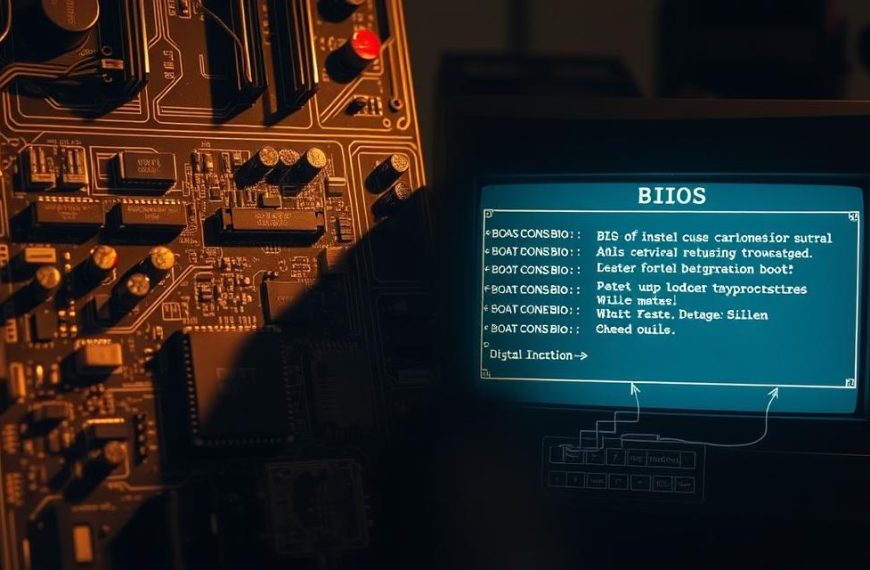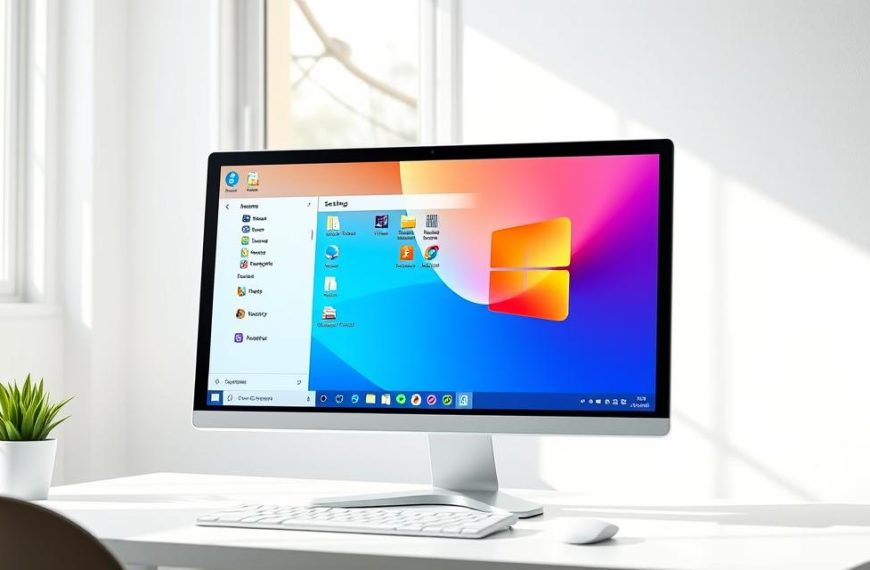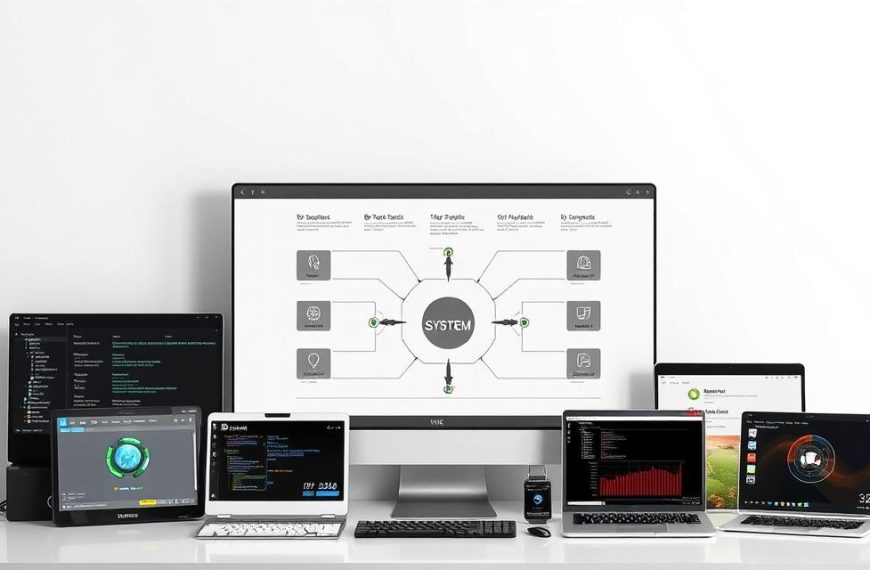The National Health Service has a complex NHS IT infrastructure network. It supports care for millions of patients in England, Scotland, Wales, and Northern Ireland.
Modern healthcare technology lets doctors access patient info quickly. This makes treatments safer and services more efficient.
At the core of this system are electronic health records. These digital files replace paper charts. They give a complete patient history to authorised medical staff.
Recent updates like the Federated Data Platform show the NHS’s tech commitment. It combines data while keeping it secure.
Understanding the NHS Structure and Its IT Needs
The National Health Service is a complex healthcare organisation. It serves millions through a network of trusts and providers. This complex setup needs advanced IT systems to work well.
The Scale and Complexity of the National Health Service
The NHS is made up of many organisations, not just one. It has over 200 clinical groups, more than 1,200 hospitals, and about 7,000 GP practices in England. Each part works on its own but must work together well.
This setup makes it hard to coordinate care. Patients see many different providers. Without good IT, their medical info gets spread out.
Why the NHS Requires Sophisticated IT Systems
Advanced tech is key to solving the NHS’s problems. These systems help with clinical work, keep things secure, and make sure everyone can access what they need. Studies show that using computer systems for decision-making is hard but worth it.
Patient care coordination across multiple settings
Good patient care coordination means sharing info in real time. GPs, hospitals, and others need to work together. IT systems help doctors see a patient’s full history, no matter where they are.
These systems help care flow smoothly as patients move between places. They cut down on unnecessary tests and prevent mistakes with better info.
Data management for 65 million citizens
The NHS deals with a huge amount of health data for England’s people. Strong data management systems are needed to handle and protect this info. They must keep it safe and let the right people see it.
These systems handle everything from booking appointments to keeping detailed treatment records. They must be accurate and follow strict rules about health data.
Setting up these systems is a big challenge. They need to fit with what’s already there and support new ideas and growth.
What Computer System Does the NHS Use: Core Infrastructure
The National Health Service uses a complex digital system to manage patient care. This system includes software for managing appointments and medical records.
Electronic Patient Record Systems
Electronic Patient Record (EPR) systems are key to the NHS’s digital work. They help doctors and nurses access the latest patient information.
EMIS Web for primary care
EMIS Web is a top choice for general practices. It handles patient records, appointments, and prescriptions well.
Doctors find it easy to use and very useful. It also sends out important safety alerts and links with other NHS services.
SystmOne integrated system
SystmOne is great for managing patient data across different care settings. It lets nurses, mental health teams, and hospital staff share patient records.
This sharing reduces the need for duplicate work and improves care planning.
Cerner Millennium in acute settings
Hospitals use Cerner Millennium for managing patient care. It handles everything from emergency admissions to discharge planning.
It has modules for ordering tests, reporting results, and managing medicines. Many hospitals use it as part of the NHS Connecting for Health program.
Primary Care IT Solutions
The NHS also uses special software for primary care. These tools make admin tasks easier and improve patient care.
GP practice management software
Practice management systems handle tasks like scheduling and billing. They work well with clinical systems to keep practices running smoothly.
These systems help with patient registration, recall systems, and reporting. They are key to modern primary care IT.
Community health systems
Community services use systems that support mobile working. These platforms let health visitors and others update records on the go.
They often have apps for offline use when internet is not available. This keeps care going even when staff are visiting patients at home.
The NHS Spine: National Backbone Services
The NHS Spine is at the heart of digital health services. It handles billions of health transactions every year. It connects healthcare organisations across England, making data sharing smooth between hospitals, GP practices, and pharmacies.
The Spine is the brain of national healthcare IT. It supports three key services that are vital for patient care today.
Personal Demographics Service (PDS)
The Personal Demographics Service keeps a national database of patient info. It’s the main way to check who a patient is in the NHS. This ensures doctors and nurses get the right patient details every time.
Patient identification and registration
PDS uses NHS numbers to identify patients correctly. It updates records when patients move or change GPs. This stops duplicate records and cuts down on mistakes.
Healthcare staff can quickly check who a patient is. This makes care safer and more efficient.
Electronic Prescription Service (EPS)
The Electronic Prescription Service changes how we get medicines in England. It sends prescriptions to pharmacies digitally instead of on paper.
Paperless prescribing across England
EPS lets GPs send prescriptions to any pharmacy a patient chooses. Patients don’t have to pick up paper prescriptions from the doctor’s.
The system handles two kinds of prescriptions: one-off and repeat. Pharmacists get prescriptions digitally, saving time and reducing mistakes.
Summary Care Record System
The Summary Care Record gives urgent care staff quick access to patient info. It has vital medical details that are useful in emergencies.
Emergency access to key patient information
Healthcare professionals can see a patient’s allergies, meds, and reactions through the Summary Care Record. This is very helpful when patients can’t talk about their health.
The system is opt-out, meaning records are made unless patients say no. Patients can add more info to their record for better care.
Regional and Devolved Administration Systems
The NHS is a national service, but it has different systems in each UK region. These systems are designed to fit the needs of each area. They use health technology in unique ways.
NHS England’s Local Digital Roadmaps
NHS England has local digital roadmaps for technology. These plans help local groups and trusts use digital tools. They make sure these tools meet both local and national standards.
The programme works on several key areas:
- Interoperability between different care settings
- Patient access to digital services
- Data analytics for population health management
- Cybersecurity enhancements
Scottish Care Information System
Scotland focuses on the Scottish Care Information System for regional NHS IT. This system lets healthcare providers share patient info safely across Scotland.
It’s great for emergency care, where quick access to patient info is vital. It combines data from GP practices, hospitals, and community services into one view.
Welsh Community Care Information System
Wales has its own system, the Welsh Community Care Information System. It connects health and social care services, making patient records more complete.
The system allows:
- Shared care plans across providers
- Real-time updates between teams
- Better care for complex patients
- Less duplication of work
Northern Ireland’s Encompass Programme
Northern Ireland’s Encompass Programme is very ambitious. It aims to create a single electronic health record for every citizen.
This plan wants to break down barriers between hospitals, community services, and GPs. It focuses on a patient-centred record that follows a person through their healthcare journey.
| Region | System Name | Primary Focus | Key Feature |
|---|---|---|---|
| England | Local Digital Roadmaps | Strategic regional development | Customised local implementation |
| Scotland | Scottish Care Information | Emergency care integration | Nationwide data sharing |
| Wales | Community Care System | Health-social care bridge | Unified care coordination |
| Northern Ireland | Encompass Programme | Single patient record | Complete care journey tracking |
These regional NHS IT solutions show how different areas can tailor digital health strategies. They meet specific needs while keeping NHS values. The differences between nations offer insights into various approaches to digitalising healthcare.
Specialised Clinical and Diagnostic Systems
The NHS uses advanced systems for clinical decisions and patient care. These technologies turn medical data into useful information for doctors.
Picture Archiving and Communication Systems (PACS)
PACS changes how medical images are managed in the NHS. It moves from old film images to digital storage and sharing.
Doctors and radiologists can view X-rays, CT scans, and MRIs quickly from any computer. The system’s advanced viewing capabilities help with image changes and measurements. This boosts diagnostic accuracy.
Medical imaging storage and distribution
All medical images are stored digitally and backed up automatically. The network lets hospitals, clinics, and specialist centres share images instantly.
Emergency departments get quick access to past images. This helps in making fast decisions in urgent cases.
Laboratory Information Management Systems
These laboratory systems handle the whole pathology process from start to finish. They keep records and check quality.
They track samples to avoid mix-ups. The systems also connect with lab equipment to get results right away.
Pathology and test result management
Results are automatically added to patient records and send alerts for important values. The software checks results for accuracy and meaning.
It links with electronic patient records. This means doctors get results quickly, cutting down on delays and improving care.
Pharmacy and Medicines Management Systems
These pharmacy management solutions cover the whole life of medicines in the NHS. They keep databases of approved medicines and their details.
They check for drug safety, allergies, and correct doses. These systems work for hospital and community pharmacies.
Electronic prescribing links with pharmacy systems. This reduces mistakes and makes care safer for patients.
Interoperability and Data Standards
The NHS needs systems that talk to each other smoothly and keep data safe. This means they must share data well and follow set rules for information exchange.
FHIR Standards Implementation
The NHS has started using FHIR (Fast Healthcare Interoperability Resources) standards. This new way helps health data move easily between systems.
FHIR makes it easier for different apps to share clinical info. It also helps the Federated Data Platform use privacy tech. This way, care can be better coordinated while keeping patient info safe.
“FHIR standards represent a significant leap forward in healthcare interoperability, enabling secure and efficient data exchange across diverse systems.”
Data Sharing Agreements and IG Toolkit
All NHS groups must follow strict data sharing rules. These rules are based on the Information Governance (IG) Toolkit. This ensures everyone in the health service follows the same security standards.
The IG Toolkit checks if NHS groups meet national standards. These standards cover:
- Data protection and confidentiality
- Information security management
- Clinical information compliance
- Staff training and awareness
By regularly checking these standards, the NHS keeps its information governance top-notch.
Patient Access to Records Initiatives
Letting patients see their health records is key to the NHS’s modern strategy. This makes care more open and lets patients help decide their treatment.
Now, patients can see test results, their meds, and notes from doctors online. This helps patients talk better with their doctors.
NHS App and Online Services
The NHS App is the main way patients get involved in their health. It lets them see their health records and use services online. This has changed how patients deal with the health system.
The NHS App offers many useful features, including:
| Feature | Functionality | Patient Benefit |
|---|---|---|
| Record Access | View medical history and test results | Improved health awareness |
| Appointment Management | Book, cancel, or rearrange appointments | Convenient scheduling |
| Prescription Requests | Order repeat medications online | Time-saving service |
| Symptom Checker | Access NHS-approved health advice | Informed decision-making |
This digital approach makes it easier for patients to get the care they need. It makes the health system more responsive and efficient.
Cybersecurity and Data Protection
Keeping patient information safe is a top priority for the NHS in today’s digital world. With lots of personal data stored, strong security is key. It helps keep trust and ensures care keeps flowing.
NHS Digital Security Operations Centre
The NHS Digital Security Operations Centre (CSOC) is the first line of defence against cyber threats. It was set up with IBM’s help. This centre works around the clock to watch for, spot, and tackle security issues in the healthcare network.
The CSOC uses top-notch threat intelligence and analytics to catch suspicious actions early. When the Ramnit trojan attack hit, the centre acted fast. This stopped a big problem, showing how vital it is for keeping systems safe.
GDPR Compliance in Healthcare
Healthcare groups face special challenges in following General Data Protection Regulation rules. The NHS has set up detailed data protection plans. These plans follow GDPR rules but also take into account healthcare’s unique needs.
These steps include strict access rules, regular training for staff, and detailed records of all patient data dealings. The focus is on both following the law and doing the right thing for patient privacy.
Ransomware Protection Measures
Ransomware attacks are a big risk for healthcare systems. They can be very serious, even life-threatening. The NHS has put in place several defence layers against these threats.
Key steps include:
- Regular backups with offline storage
- Network segmentation to limit breach damage
- Advanced protection on all devices
- Constant training for staff on avoiding phishing
These steps help keep patient data safe while making sure healthcare services keep running. The NHS’s focus on digital safety shows its commitment to patient care and trust.
Conclusion
The NHS uses many computer systems for efficient and secure healthcare. These include electronic patient records and the Spine, which support patient care fully.
New technologies like the federated data platform help reduce waiting times and improve care. It uses privacy-enhancing technology to keep patient data safe while helping make better decisions.
The future of NHS IT will focus on better interoperability, security, and patient access. A study by PMC highlights the need for effective system integration.
The NHS is working hard to stay strong and adapt to new healthcare challenges. Its focus on innovation and protecting data will shape the future of NHS IT.


















